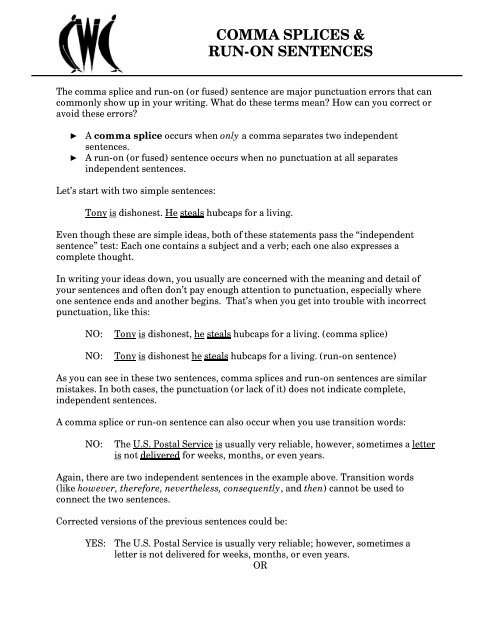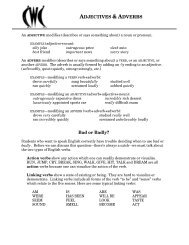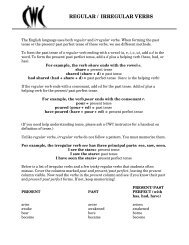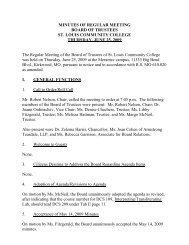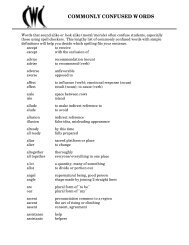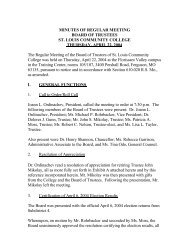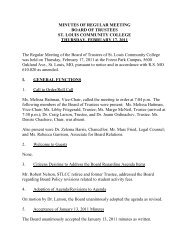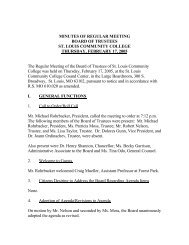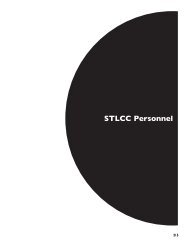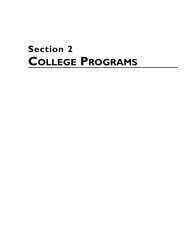COMMA SPLICES & RUN-ON SENTENCES
COMMA SPLICES & RUN-ON SENTENCES
COMMA SPLICES & RUN-ON SENTENCES
You also want an ePaper? Increase the reach of your titles
YUMPU automatically turns print PDFs into web optimized ePapers that Google loves.
<strong>COMMA</strong> <strong>SPLICES</strong> &<br />
<strong>RUN</strong>-<strong>ON</strong> <strong>SENTENCES</strong><br />
The comma splice and run-on (or fused) sentence are major punctuation errors that can<br />
commonly show up in your writing. What do these terms mean? How can you correct or<br />
avoid these errors?<br />
► A comma splice occurs when only a comma separates two independent<br />
sentences.<br />
► A run-on (or fused) sentence occurs when no punctuation at all separates<br />
independent sentences.<br />
Let’s start with two simple sentences:<br />
Tony is dishonest. He steals hubcaps for a living.<br />
Even though these are simple ideas, both of these statements pass the “independent<br />
sentence” test: Each one contains a subject and a verb; each one also expresses a<br />
complete thought.<br />
In writing your ideas down, you usually are concerned with the meaning and detail of<br />
your sentences and often don’t pay enough attention to punctuation, especially where<br />
one sentence ends and another begins. That’s when you get into trouble with incorrect<br />
punctuation, like this:<br />
NO: Tony is dishonest, he steals hubcaps for a living. (comma splice)<br />
NO: Tony is dishonest he steals hubcaps for a living. (run-on sentence)<br />
As you can see in these two sentences, comma splices and run-on sentences are similar<br />
mistakes. In both cases, the punctuation (or lack of it) does not indicate complete,<br />
independent sentences.<br />
A comma splice or run-on sentence can also occur when you use transition words:<br />
NO: The U.S. Postal Service is usually very reliable, however, sometimes a letter<br />
is not delivered for weeks, months, or even years.<br />
Again, there are two independent sentences in the example above. Transition words<br />
(like however, therefore, nevertheless, consequently, and then) cannot be used to<br />
connect the two sentences.<br />
Corrected versions of the previous sentences could be:<br />
YES: The U.S. Postal Service is usually very reliable; however, sometimes a<br />
letter is not delivered for weeks, months, or even years.<br />
OR
YES: The U.S. Postal Service is usually very reliable. However, sometimes a<br />
letter is not delivered for weeks, months, or even years.<br />
Look carefully at the next example. IS THERE A <strong>RUN</strong>-<strong>ON</strong> SENTENCE OR <strong>COMMA</strong><br />
SPLICE PROBLEM IN THE FOLLOWING?<br />
Because Jonathan is very competitive, he sometimes puts too much pressure on<br />
himself.<br />
THE ABOVE IS <strong>ON</strong>E COMPLETE, CORRECTLY PUNCTUATED SENTENCE. Even<br />
though both parts of the sentence have a subject and verb, the dependent word because<br />
keeps the first idea from expressing a complete thought. It is dependent on the second<br />
part of the sentence to complete the meaning. Some common dependent words<br />
(subordinate conjunctions) are because, after, although, if, until, since, and while.<br />
Now that you know how sentences become run-on/fused sentences or comma splices,<br />
how do you avoid or correct them? Four basic methods can be used:<br />
1. Use a comma and coordinating conjunction (and, but, or, nor, for,<br />
yet, and so) to form one smooth sentence:<br />
Sentence, and sentence.<br />
NO: Communication is important in every relationship, it’s especially<br />
important to a newly married couple.<br />
YES: Communication is important in every relationship, but it’s especially<br />
important to a newly married couple.<br />
2. Separate the independent sentences with a semicolon. The semicolon<br />
may be used whether or not the second sentence starts with a<br />
transitional word or phrase.<br />
Sentence; sentence.<br />
or<br />
Sentence; transition, sentence.<br />
NO: Suddenly, there was complete silence in the boys’ room then the mother<br />
knew she’d better check on them.<br />
YES: Suddenly, there was complete silence in the boys’ room; then the mother<br />
knew she’d better check on them.
3. Make the independent sentences distinct, using a period and capital<br />
letter.<br />
Sentence. Sentence.<br />
NO: Saturday afternoon in Kirkwood is always a busy time everyone seems to<br />
be out running errands.<br />
YES: Saturday afternoon in Kirkwood is always a busy time. Everyone seems to<br />
be out running errands.<br />
4. Restructure the two sentences as one, using a dependent word to<br />
introduce the less important idea.<br />
Dependent word+subject/verb, sentence.<br />
NO The new organizational plan was introduced, the company employees were<br />
eager to try it.<br />
YES When the new organizational plan was introduced, the company<br />
employees were eager to try it.<br />
Besides this handout, the CWC has several worksheets for practice in correcting runon/fused<br />
and comma splice problems. Ask for them and bring them back to have a<br />
staff member check over the corrections you’ve made.<br />
Revised 2004<br />
at Meramec


